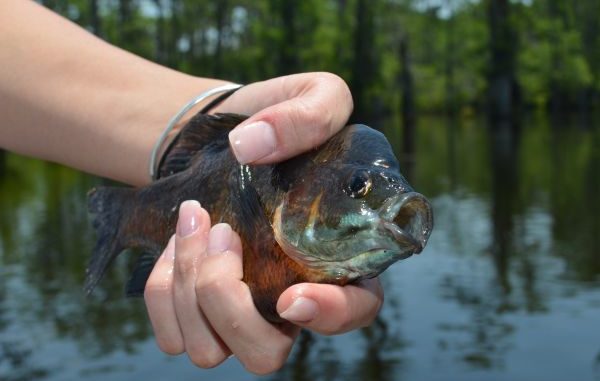
For some unknown reason, big male bluegills are called “bulls.” Why is hard to figure out. Females aren’t called “cows,” and young bluegills aren’t called “calves.”
In any case, this feisty species is definitely the backbone of the bream fishery. At least the males are.
Males and females appear dramatically different in coloration. Females will have six or seven broad, vertical olive-colored bars set on a yellow background of varying intensity. Females are also substantially smaller than males.
Spawning bulls are truly beautiful creatures. They have head profiles so domed that their “faces” look creased. Most noticeable are their unmistakable copper-colored bellies and the bright blue-green coloration of their lower gill covers and the lower jaws.
Their overall body color is dominated by olive hues in varying shades. Body, belly and jaw/gill cover colors will vary with the color of the water the fish came from.
The darkest fish will appear almost black and invariably come from clear water, darkly stained with tannic acid (swamp water). Fish from muddy water will show the least-intense colors.
Several things make bull bluegills such a desirable bream species.
First, they get big — 10 inches long. That\’s big for a bream.
Second, spawning males bunch up in big numbers. Like other members of its family, including black bass, it spawns in nests — circular, plate-sized depressions that the males sweep out of the bottom.
Unlike many of its fellow family members, though, it forms dense beds, sometimes holding 500 nests placed side by side in areas of favorable habitat. When fishermen find a bed early in the spawning season, they can take a lot of fish out of a small area.
Third, bull bluegills are aggressive. They grab anything, living or dead, that falls within the orbit of their nests. Whether defending the nest site or simply ravenous because the demands of spawning mean that they can\’t leave their nest site is irrelevant. What counts is that they bite.
Fourth, male bluegills are in spawning mode, unlike most other members of their family, for a full four months: May through August. Other sunfish or bass spawn once, then head for the easy chair, feeding only when they feel the urge. Bull bluegills spawn over and over again for the whole summer.
But August is not May. Yes, they\’re spawning in both months, but things are different.
For one thing, there are just fewer of them around. For months, the big males have been in the shallows, exposed to predators, not the least of which are humans.
With so many of them missing, the big beds are picked over or gone.
In big colonies, the best nest sites are those in the center of the bed because egg-stealers will enter the colony from the edges and usually don\’t make it to the center.
Male bluegills compete intensely for these best sites, and larger males usually win. That competition is gone by August, and many males will nest in solitary nests.
On top of that, bull bluegills are simply less aggressive late in the season; they are far less likely to rise to the surface to aggressively whack a popping bug in August than in May.
The wear and tear of the long spawning season also shows on the fish physically. Many are thin — extremely thin — so thin that in cross-section they resemble wood-splitting wedges. And by late in the season, for whatever reason, lots of them have skin abrasions and sores, some that are pretty impressive in size.
If fish could reason, the end of spawning season would probably come as a relief to bull bluegills. In September their colors gradually fade, with their copper bellies turning to yellow.
By the dead of winter, males are nearly as drab as females, but are still easily recognizable by their prominent foreheads.


